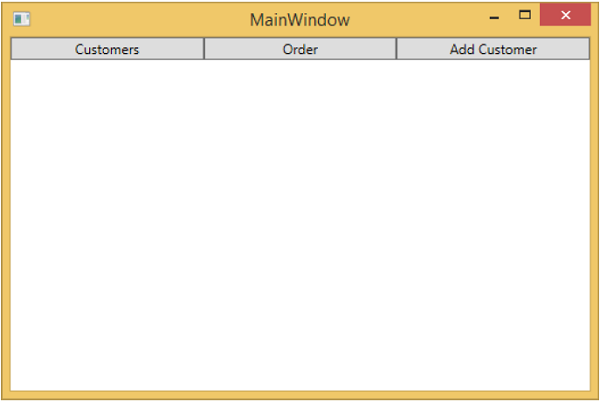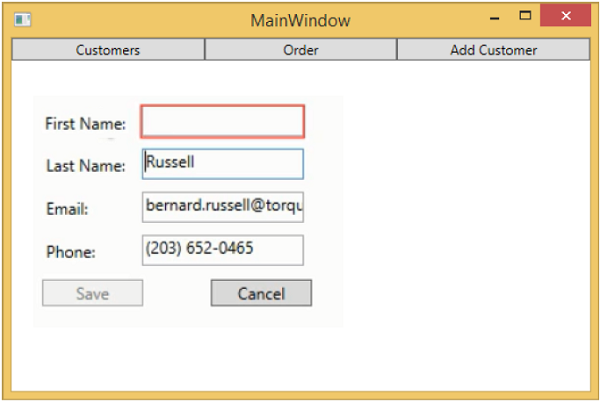
- MVVM - Home
- MVVM – Introduction
- MVVM - Advantages
- MVVM - Responsibilities
- MVVM - First Application
- MVVM - Hooking Up Views
- MVVM - Hooking Up ViewModel
- MVVM - WPF Data Bindings
- MVVM - WPF Data Templates
- MVVM - ViewModel Communication
- MVVM - Hierarchies & Navigation
- MVVM - Validations
- MVVM - Dependency Injection
- MVVM - Events
- MVVM - Unit Testing
- MVVM - Frameworks
- MVVM - Interview Questions
MVVM Dependency Injection
In this chapter, we will briefly discuss about dependency injection. We have already covered data binding decouples Views and ViewModels from each other that allows them to communicate without knowing explicitly what is going on at the other end of the communication.
Now we need something similar to decouple our ViewModel from the client services.
In early days of object-oriented programming, developers have faced the issue of creating and retrieving instances of classes in applications. Various solutions have been proposed for this problem.
For the past few years, dependency injection and inversion of control (IoC) have gained popularity among developers and have taken precedence over some older solutions such as the Singleton pattern.
Dependency Injection / IoC Containers
IoC and dependency injection are two design patterns that are closely related and the container is basically a chunk of infrastructure code that does both of those patterns for you.
IoC pattern is about delegating responsibility for construction and the dependency injection pattern is about providing dependencies to an object that's already been constructed.
-
They can both be treated as a two-phase approach to constructing. When you use a container, the container takes several responsibilities which are as follows −
- It constructs an object when asked.
- The container will determine what that object depends on.
- Constructing those dependencies.
- Injecting them into the object being constructed.
- Recursively doing process.
Let's have a look at how we can use dependency injection to break decoupling between ViewModels and the client services. We will wire up the save handling AddEditCustomerViewModel form by using dependency injection related to that.
First we need to create a new interface in our project in Services folder. If you dont have a services folder in your project then create it first and add the following interface in the Services folder.
using MVVMHierarchiesDemo.Model;
using System;
using System.Collections.Generic;
using System.Linq;
using System.Text;
using System.Threading.Tasks;
namespace MVVMHierarchiesDemo.Services {
public interface ICustomersRepository {
Task<List<Customer>> GetCustomersAsync();
Task<Customer> GetCustomerAsync(Guid id);
Task<Customer> AddCustomerAsync(Customer customer);
Task<Customer> UpdateCustomerAsync(Customer customer);
Task DeleteCustomerAsync(Guid customerId);
}
}
Following is the implementation of ICustomersRepository.
using MVVMHierarchiesDemo.Model;
using System;
using System.Collections.Generic;
using System.Linq; using System.Text;
using System.Threading.Tasks;
namespace MVVMHierarchiesDemo.Services {
public class CustomersRepository : ICustomersRepository {
ZzaDbContext _context = new ZzaDbContext();
public Task<List<Customer>> GetCustomersAsync() {
return _context.Customers.ToListAsync();
}
public Task<Customer> GetCustomerAsync(Guid id) {
return _context.Customers.FirstOrDefaultAsync(c => c.Id == id);
}
public async Task<Customer> AddCustomerAsync(Customer customer){
_context.Customers.Add(customer);
await _context.SaveChangesAsync();
return customer;
}
public async Task<Customer> UpdateCustomerAsync(Customer customer) {
if (!_context.Customers.Local.Any(c => c.Id == customer.Id)) {
_context.Customers.Attach(customer);
}
_context.Entry(customer).State = EntityState.Modified;
await _context.SaveChangesAsync();
return customer;
}
public async Task DeleteCustomerAsync(Guid customerId) {
var customer = _context.Customers.FirstOrDefault(c => c.Id == customerId);
if (customer != null) {
_context.Customers.Remove(customer);
}
await _context.SaveChangesAsync();
}
}
}
The simple way to do Save handling is to add a new instance of ICustomersRepository in AddEditCustomerViewModel and overload the AddEditCustomerViewModel and CustomerListViewModel constructor.
private ICustomersRepository _repo;
public AddEditCustomerViewModel(ICustomersRepository repo) {
_repo = repo;
CancelCommand = new MyIcommand(OnCancel);
SaveCommand = new MyIcommand(OnSave, CanSave);
}
Update the OnSave method as shown in the following code.
private async void OnSave() {
UpdateCustomer(Customer, _editingCustomer);
if (EditMode)
await _repo.UpdateCustomerAsync(_editingCustomer);
else
await _repo.AddCustomerAsync(_editingCustomer);
Done();
}
private void UpdateCustomer(SimpleEditableCustomer source, Customer target) {
target.FirstName = source.FirstName;
target.LastName = source.LastName;
target.Phone = source.Phone;
target.Email = source.Email;
}
Following is the complete AddEditCustomerViewModel.
using MVVMHierarchiesDemo.Model;
using MVVMHierarchiesDemo.Services;
using System;
using System.Collections.Generic;
using System.Linq;
using System.Text;
using System.Threading.Tasks;
namespace MVVMHierarchiesDemo.ViewModel {
class AddEditCustomerViewModel : BindableBase {
private ICustomersRepository _repo;
public AddEditCustomerViewModel(ICustomersRepository repo) {
_repo = repo;
CancelCommand = new MyIcommand(OnCancel);
SaveCommand = new MyIcommand(OnSave, CanSave);
}
private bool _EditMode;
public bool EditMode {
get { return _EditMode; }
set { SetProperty(ref _EditMode, value); }
}
private SimpleEditableCustomer _Customer;
public SimpleEditableCustomer Customer {
get { return _Customer; }
set { SetProperty(ref _Customer, value); }
}
private Customer _editingCustomer = null;
public void SetCustomer(Customer cust) {
_editingCustomer = cust;
if (Customer != null) Customer.ErrorsChanged -= RaiseCanExecuteChanged;
Customer = new SimpleEditableCustomer();
Customer.ErrorsChanged += RaiseCanExecuteChanged;
CopyCustomer(cust, Customer);
}
private void RaiseCanExecuteChanged(object sender, EventArgs e) {
SaveCommand.RaiseCanExecuteChanged();
}
public MyIcommand CancelCommand { get; private set; }
public MyIcommand SaveCommand { get; private set; }
public event Action Done = delegate { };
private void OnCancel() {
Done();
}
private async void OnSave() {
UpdateCustomer(Customer, _editingCustomer);
if (EditMode)
await _repo.UpdateCustomerAsync(_editingCustomer);
else
await _repo.AddCustomerAsync(_editingCustomer);
Done();
}
private void UpdateCustomer(SimpleEditableCustomer source, Customer target) {
target.FirstName = source.FirstName;
target.LastName = source.LastName;
target.Phone = source.Phone;
target.Email = source.Email;
}
private bool CanSave() {
return !Customer.HasErrors;
}
private void CopyCustomer(Customer source, SimpleEditableCustomer target) {
target.Id = source.Id;
if (EditMode) {
target.FirstName = source.FirstName;
target.LastName = source.LastName;
target.Phone = source.Phone;
target.Email = source.Email;
}
}
}
}
When the above code is compiled and executed, you will see the same output but now ViewModels are more loosely decoupled.

When you press the Add Customer button, you will see the following view. When the user leaves any field empty, then it will become highlighted and the save button will become disabled.
